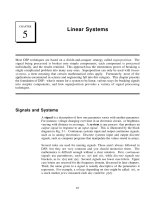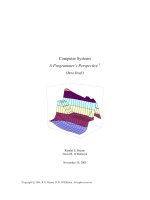Laboratory: Systems Projects
Bạn đang xem bản rút gọn của tài liệu. Xem và tải ngay bản đầy đủ của tài liệu tại đây (32.85 KB, 4 trang )
G
Laboratory: Systems Projects
This chapter presents some ideas for systems projects. We usually do
about six or seven projects in a 15-week semester, meaning one every two
weeks or so. The first few are usually done by a single student, and the
last few in groups of size two.
Each semester, the projects follow this same outline; however, we vary
the details to keep it interesting and make “sharing” of code across semesters
more challenging (not that anyone would do that!). We also use the Moss
tool [M94] to look for this kind of “sharing”.
As for grading, we’ve tried a number of different approaches, each
of which have their strengths and weaknesses. Demos are fun but time
consuming. Automated test scripts are less time intensive but require a
great deal of care to get them to carefully test interesting corner cases.
Check the book web page for more details on these projects; if you’d like
the automated test scripts, we’d be happy to share.
G.1 Intro Project
The first project is an introduction to systems programming. Typical
assignments have been to write some variant of the sort utility, with
different constraints. For example, sorting text data, sorting binary data,
and other similar projects all make sense. To complete the project, one
must get familiar with some system calls (and their return error codes),
use a few simple data structures, and not much else.
G.2
U NIX Shell
In this project, students build a variant of a U NIX shell. Students learn
about process management as well as how mysterious things like pipes
and redirects actually work. Variants include unusual features, like a
redirection symbol that also compresses the output via gzip. Another
variant is a batch mode which allows the user to batch up a few requests
and then execute them, perhaps using different scheduling disciplines.
1
2
L ABORATORY: S YSTEMS P ROJECTS
G.3 Memory-allocation Library
This project explores how a chunk of memory is managed, by building
an alternative memory-allocation library (like malloc() and free()
but with different names). The project teaches students how to use mmap()
to get a chunk of anonymous memory, and then about pointers in great
detail in order to build a simple (or perhaps, more complex) free list to
manage the space. Variants include: best/worst fit, buddy, and various
other allocators.
G.4 Intro to Concurrency
This project introduces concurrent programming with POSIX threads.
Build some simple thread-safe libraries: a list, hash table, and some more
complicated data structures are good exercises in adding locks to realworld code. Measure the performance of coarse-grained versus fine-grained
alternatives. Variants just focus on different (and perhaps more complex)
data structures.
G.5 Concurrent Web Server
This project explores the use of concurrency in a real-world application. Students take a simple web server (or build one) and add a thread
pool to it, in order to serve requests concurrently. The thread pool should
be of a fixed size, and use a producer/consumer bounded buffer to pass
requests from a main thread to the fixed pool of workers. Learn how
threads, locks, and condition variables are used to build a real server.
Variants include scheduling policies for the threads.
G.6 File System Checker
This project explores on-disk data structures and their consistency.
Students build a simple file system checker. The debugfs tool can be
used on Linux to make real file-system images; crawl through them and
make sure all is well. To make it more difficult, also fix any problems that
are found. Variants focus on different types of problems: pointers, link
counts, use of indirect blocks, etc.
G.7 File System Defragmenter
This project explores on-disk data structures and their performance
implications. The project should give some particular file-system images
to students with known fragmentation problems; students should then
crawl through the image, and look for files that are not laid out sequentially. Write out a new “defragmented” image that fixes this problem,
perhaps reporting some statistics.
O PERATING
S YSTEMS
[V ERSION 0.90]
WWW. OSTEP. ORG
L ABORATORY: S YSTEMS P ROJECTS
3
G.8 Concurrent File Server
This project combines concurrency and file systems and even a little
bit of networking and distributed systems. Students build a simple concurrent file server. The protocol should look something like NFS, with
lookups, reads, writes, and stats. Store files within a single disk image
(designed as a file). Variants are manifold, with different suggested ondisk formats and network protocols.
c 2014, A RPACI -D USSEAU
T HREE
E ASY
P IECES
4
L ABORATORY: S YSTEMS P ROJECTS
References
[M94] “Moss: A System for Detecting Software Plagiarism”
Alex Aiken
Available: />
O PERATING
S YSTEMS
[V ERSION 0.90]
WWW. OSTEP. ORG









